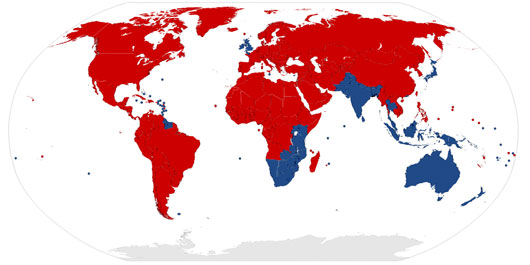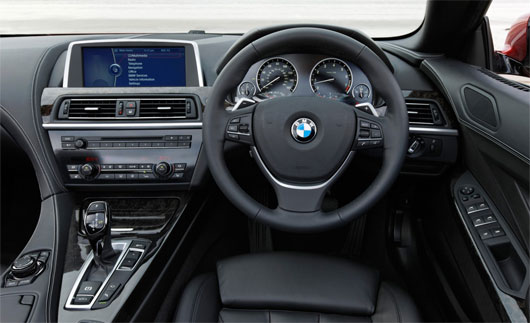Why do you and many other countries in the world drive left?
Surely many of us wonder why the UK and some countries in the world, people drive left instead of right like Vietnam and most other countries? What other driver on the left and where does this law come from?
Where applicable Left-hand Traffic (LHT):

Driving countries on the left (blue)
Not only England, many other countries in the world forced drivers to drive on the left. Below is a list of countries and territories that apply the law of driving on the left. There are many territories of England and some countries that used to be colonies or autonomous regions of the British Union.
British and British autonomous territories: Anguilla Island, British Virgin Islands, Cayman Islands, Falkland Islands, Isle of Man Island, Montserrat Island, St. Island Helena, Turks & Caicos Islands.
Asia: Bangladesh, Bhutan, Brunei, Hong Kong, India, Indonesia, Japan, Macau, Malaysia, Nepal, Pakistan, Singapore, Sri Lanka and Thailand.
Europe: Cyprus, Ireland and Northern Ireland, Malta, Scotland, Wales.
Africa: Botswana, Kenya, Lesotho, Malawi, Mauritius, Mozambique, Namibia, Seychelles, South Africa, Surinam, Swaziland, Tanzania, Tonga, Trinidad & Tobago, Rwanda, Zambia, Zimbabwe.
America: Antigua & Barbuda, Bahamas, Barbados, Bermuda, Dominica, Grenada, Guyana, Jamaica, St Kitts & Nevis, St. Lucia, the US Virgin Islands, St. Vincent & Grenadines.
Oceania: Australia, Fiji, New Zealand, Papua New Guinea, Samoa, Solomon Islands.
Steering wheel on the car on the right or left?

Steering wheel to the right of a BMW 640i
Because of driving on the left, cars are also required to have a right-hand Drive (RHD) setting right. However, some places on the list above drive on the left but still use the cars with the left-hand seats (LHD). Specifically, in the British Virgin Islands, the US Virgin Islands, Cayman Islands, Turks & Caicos Islands and the Bahamas, most vehicles are equipped with left-hand steering wheel because they are imported from the US and Brazil.
So what is left driving?

The direction of the vehicle running on the left corresponds to the turn situations
- All vehicles involved in road traffic must go to the left of the road, except when crossing the vehicles, they must encroach upon them;
- Vehicles going in the opposite direction will be on the right side of the road;
- Most traffic signals such as street lights and signs are placed on the left side of the road;
- Means of going round the roundabout clockwise;
- People walking to the road at a 2-way street must first observe the vehicle on the right;
- The lane for normal vehicles will be left when the vehicle turns left;
- Most lanes of highways have a way out on the left;
- The vehicles overtake each other to the right, in some cases overtaking is allowed;
- Most vehicles have driver's seat on the right;
- When the red light is on, the vehicle may be allowed to turn left.
Driving left and right, which side is safer?
According to a study done in 1969 by Professor JJ Leeming, countries that apply the law of driving on the left have a lower traffic collision rate than countries that apply the right driving law.
His research suggests that the right eye of the human is more dominant than the left eye. When driving on the left, the right eye with better capacity is used more to monitor the reverse traffic direction and the rear view mirror near the driver. In addition, there are many opinions that driving to the left is safer for the elderly because it seems that aging makes the ability to focus eyesight on the left decrease and especially the ability to observe vehicles are approaching the left at intersections. Moreover, for cars with steering wheel settings on the right, use the floor number, the driver will use the right hand to control the car more because this is usually the dominant hand and use the left hand to shift the gear as well as perform the Other functions.

Warning alert on the right when crossing the road in England
For cyclists, motorbikes and horsebackers, most of them climb on the car from the left, the footrest is always on the left. So when driving on the left, getting on and off will be safer. However, for pedestrians, especially those coming from a driving country on the right, they will have some difficulty in navigating when crossing the street because instead of watching the car on the left They will have to turn to the right.
Driving left and right, which side is first?
In 1998, archaeologists found a trail leading to a Roman quarry, near Swindon, England. The wheel marks on the left side (seen from the direction of the quarry come out) are deeper than the right tire tracks. These traces suggest that the ancient Romans had walked to the left of the road, at least in this area, because the wagons that hauled stones from the mines would be heavier, thus creating deep wheel marks than. And when entering, the car is empty so the wheels are more shallow.
Some historians like C. Northcote Parkinson believe that ancient travelers on horse-drawn cars often run to the left of the road. Since most people are right-handed, a horsebacker will be able to hold the outline with his left hand and let his right hand free to greet the person who goes back or protect himself with a sword if necessary.
The history of walking on the left comes from ancient Greece, Egypt and Rome and is more widely used than on the right. Ancient Greeks, Egyptians and Romans often marched to the left of the road. If 2 cavalry rushes to fight, each person will approach each other to his right. Therefore, they can draw swords from the right and keep the defensive position. From a habit, go left to become a tradition and then become a law. The law on the left is well established in Roman times because cities always have a heavy traffic density.
In a Roman city, horse-drawn carriages and horse-drawn wagons were banned throughout the day; In other places, vehicles with wheels are prohibited from being used throughout the night so as not to disturb people's sleep. Pilgrims who want to return to their cities are guided to the left. During this time, the pope asked to give instructions to the left of the road and this law was widely used and even today still applies by many countries.
The Straight Dope - a prestigious question and answer site dating back to 1973 answered the question "Why do British people drive left?" as follows:
"In the Middle Ages, you go to the left of the road for a simple reason that you will not know how the person you meet on the road. You want to make sure a stranger crosses you on the right to be able to make it in time. pluck the sword in case that person has a threatening behavior.
This custom was ratified in 1300 BC when Pope Boniface VIII invented a modern traffic control model by forcing all pilgrims to Rome to go to the left of the road.

This system of traffic rules was maintained until the end of the 18th century when the carriage drivers in the US and France began using cars pulled by many pairs of horses to transport agricultural products. These cars do not have seats for the wielder. Instead, the driver sits on the back of the last horse on the left so that the right hand can freely whip (above). Due to sitting on the left, naturally you will want the person to go the other way to go to his left side so that you can look down and make sure that under their wheels there is no suspicion. For this reason, you must go to the right of the road.
The law that required the first right-handers in the United States to be issued in Pennsylvania in 1792 and many years later, many other states and Canadian counties also adopted the law.
In France, the customs of the right are also formed in the same way. However, there was another motivating factor since the French revolution broke out, the papal influence was weakened and the people began to disobey the pope's demands. Afterwards, Napoleon enacted laws to the right on all the countries where his troops occupied such as the Netherlands, Switzerland, Germany, Italy, Poland and Spain. This custom was maintained even when the Napoleonic Empire collapsed.

An ancient painting shows the carriage carriage to the left of the road
In the UK, for horse-drawn riders, they sit on a rear bench instead of on horseback and normally on the right so that when whipping, the whip will not get in the back. Until now, the British still drove to the left and modern cars were also designed seats for the driver on the right. The first law of driving on the left was issued in England in 1756. Although contrary to the general trend of the world, driving on the left is not only a requirement but also a tradition of the land blind. The old British colonies like India and Indonesia kept this tradition since the 19th century. "
The transition from right-to-left driving in some countries

In Africa, the former Portuguese colony of Mozambique kept the custom of driving to the left so far although Portugal turned to driving right in the 1920s. One of the reasons why this country holds The law of driving on the left since colonial times is that all countries bordering on the border are former British colonies and influenced by British driving style. Namibia - a former German colony from 1884 to World War I still has the custom of driving right. However, after being occupied by South Africa in 1918, the country switched to driving to the left. In independence in 1990, Namibia retained the same driving style as its two neighbors, South Africa and Botswana.
Another country in Oceania, Samoa, has just changed the law of driving to the left in September 2006. The government has issued new laws to accommodate other South Pacific countries. In the period of encouragement, more than 170,000 Samoa live in Australia and New Zealand bring their cars to their homeland. Similarly, Rwanda - the former former continent of Belgium that applied the right driving law had to turn left to accommodate other countries of the East African community (EAC).
- Scientific explanation for the right-to-left confusion
- Why is there water running on the right, with water on the left?
- Just the size of an atom, this will be the smallest hard drive in the world
- The blind will also drive the car
- The advantages of left-handed people that you don't recognize
- The mystery of the tendency is 'off the left' that people don't recognize
- Small hard drive equivalent to USB drive
- This year's World Cup has five countries with less than 5 million people, but one country has won the world championship
- Disadvantage of left-handed people
- 20 amazing discoveries about countries around the world
- 9 countries own the most unique and most unique things in the world
- The fun of left-handed people
 'Fine laughs' - Scary and painful torture in ancient times
'Fine laughs' - Scary and painful torture in ancient times The sequence of numbers 142857 of the Egyptian pyramids is known as the strangest number in the world - Why?
The sequence of numbers 142857 of the Egyptian pyramids is known as the strangest number in the world - Why? History of the iron
History of the iron What is alum?
What is alum?